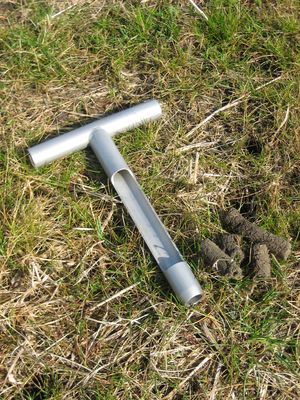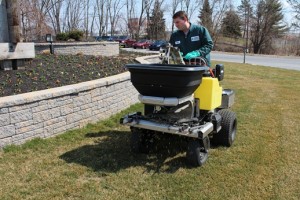 Closing day on your new home is finally here! There are final details to work out and a TON of paperwork to sign…but now the home is yours! But where to find a lawn care tip?
Closing day on your new home is finally here! There are final details to work out and a TON of paperwork to sign…but now the home is yours! But where to find a lawn care tip?
You’ve been dreaming about this for a while, and want everything to be perfect! Between the furniture, paint colors, window treatments, and house warming party, the lawn care is usually one of the last things on the list. And that’s where most first-time homeowners go wrong.
Here’s a list of some things you should consider immediately upon closing:
Lawn Care Tip #1 – Soil Testing
Growing and maintaining turf is a difficult proposition under the best of circumstances. Any one of several factors can derail the best laid plans when it comes to turf management. Why leave things to chance when you can proactively impact the result? That’s where soil testing comes in.
 We’ve seen homeowners pick up a kit, pull the samples, and mail them off themselves. We’ve also seen homeowners contact a reputable contractor and have them do the work. In either scenario, a soil test gives you helpful, valuable information – namely about soil pH and nutrient deficiencies. If your turf is low on potassium for instance, it’ll be difficult for the root system to develop and stay healthy. Fertilization alone, later in the season, may not resolve the issue, so knowing this information is exceptionally valuable. You don’t need to wait on soil test results to move on to the other steps, especially considering that these results can often take weeks to return.
We’ve seen homeowners pick up a kit, pull the samples, and mail them off themselves. We’ve also seen homeowners contact a reputable contractor and have them do the work. In either scenario, a soil test gives you helpful, valuable information – namely about soil pH and nutrient deficiencies. If your turf is low on potassium for instance, it’ll be difficult for the root system to develop and stay healthy. Fertilization alone, later in the season, may not resolve the issue, so knowing this information is exceptionally valuable. You don’t need to wait on soil test results to move on to the other steps, especially considering that these results can often take weeks to return.
Soil tests are not expensive, but they are an important part of establishing the dream lawn at your new dream home. Get it done.
Lawn Care Tip #2 – Regular Fertilization and Weed Control
Once you’ve addressed the soil test, you should establish a regular fertilization and weed control schedule. There is no need to wait for your soil test results to start this process!!
In our area, the standard that generates the best results tends to be treating the lawn 5 to 6 times each growing season (Spring, Summer and Fall). The regular fertilization will keep the turf healthy and drought-resistant throughout the growing season (note: drought-resistant, not drought-proof!) and the weed control will reduce the weeds that would compete for those nutrients. Both are vital to maintaining thick, healthy turf.
There are many Do-It-Yourself program options available for the determined homeowner. These often only incorporate four applications per year instead of the recommended six. This is largely due to marketing efforts of the companies that produce these products, not necessarily a scientifically based assessment that our region needs that number of applications. Many homeowners have trouble navigating through both the products they should be using and the timing of these applications for their lawn. This often requires a little determined “homework,” but is certainly an achievable goal.
 Identifying a reputable contractor to work with you on this is often a great short-cut, especially if it’s a neglected lawn or a newly installed lawn on a new construction home. Often the cost of buying the products yourself and hiring a contractor is very comparable, once you factor in the time you, as the homeowner, invest in the project. Your service provider can also counsel you on other issues that may arise, such as the need for grub control or disease prevention. Your contractor should also be knowledgeable enough to offer you advise on cultural practices like mowing and watering as well.
Identifying a reputable contractor to work with you on this is often a great short-cut, especially if it’s a neglected lawn or a newly installed lawn on a new construction home. Often the cost of buying the products yourself and hiring a contractor is very comparable, once you factor in the time you, as the homeowner, invest in the project. Your service provider can also counsel you on other issues that may arise, such as the need for grub control or disease prevention. Your contractor should also be knowledgeable enough to offer you advise on cultural practices like mowing and watering as well.
You should look for a business with professional associations (in Pennsylvania, you should look for membership in the Lawn Care Association of Pennsylvania, or LCAP), as well as good online reviews and awards the company has won from publications in your area.
Lawn Care Tip #3 – Aeration and Seeding
We have a clay based soil here in Central Pennsylvania. Clay soil gets very hard and compacted over time, which has seriously negative consequences for your turf. Regular, mechanical aeration of the soil is the only truly viable remedy for this. Otherwise, water cannot reach the roots, the roots cannot spread properly (think about a potted plant that is root-bound), and the roots do not have the oxygen they need to stay healthy. Mechanical core aeration should be done annually for best results. Fall is the best time of year to do this.
One important note: we often hear from clients about “tine” aerators. These are solid spikes that merely poke holes in the turf (almost like athletic cleats). This type of aeration only makes the compacted nature of the soil worse, not better. This type of aeration must be done with a “hollow tine” that pulls a “core” of soil out.
Most lawns can use some degree of seeding, and this is especially true in “new construction” homes that have been built in the last 1-3 years. While you’ve got the ground open with all these holes from your aeration, you should take advantage of the opportunity to seed as well. Seed will fall into the holes that have been created by the aeration equipment. Once in the soil, it’s protected from elements (too much sun) and animals (usually birds) that could affect germination results. Keep it lightly watered (just a little bit damp) until the seed begins to germinate. Then, replace with 2 slow, deep waterings on a weekly basis. Again, fall is the best time of year to do this in our area. It should ideally be done 3-4 weeks prior to hard ground freezing. Dormant seeding (later in the year) is also an option.
Following these three simple steps will set you, and the lawn at your new home, on the right path. If you have further questions, or would like to take advantage of a free consultation for your property, we’d be thrilled to speak with you – don’t hesitate to contact us!

